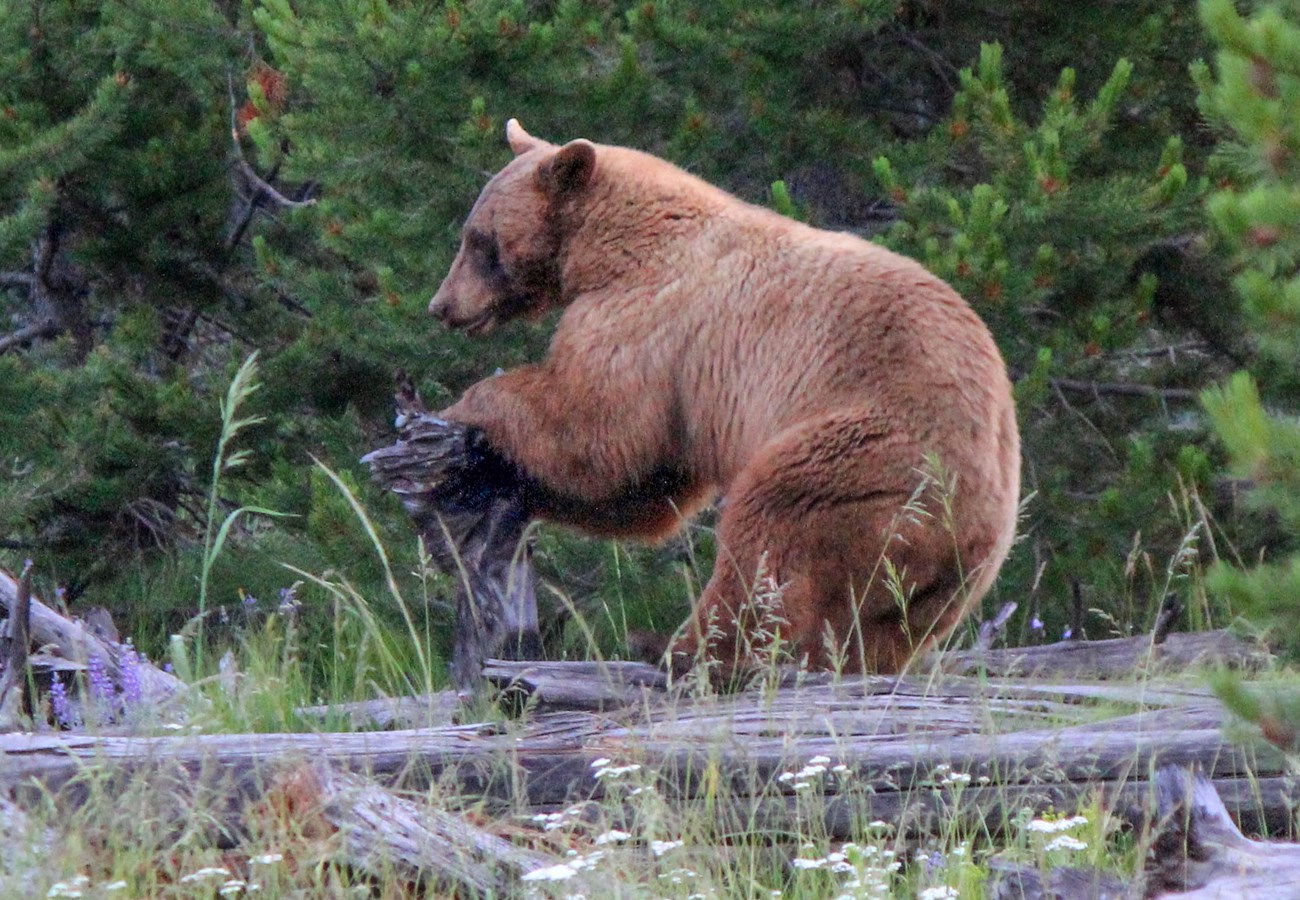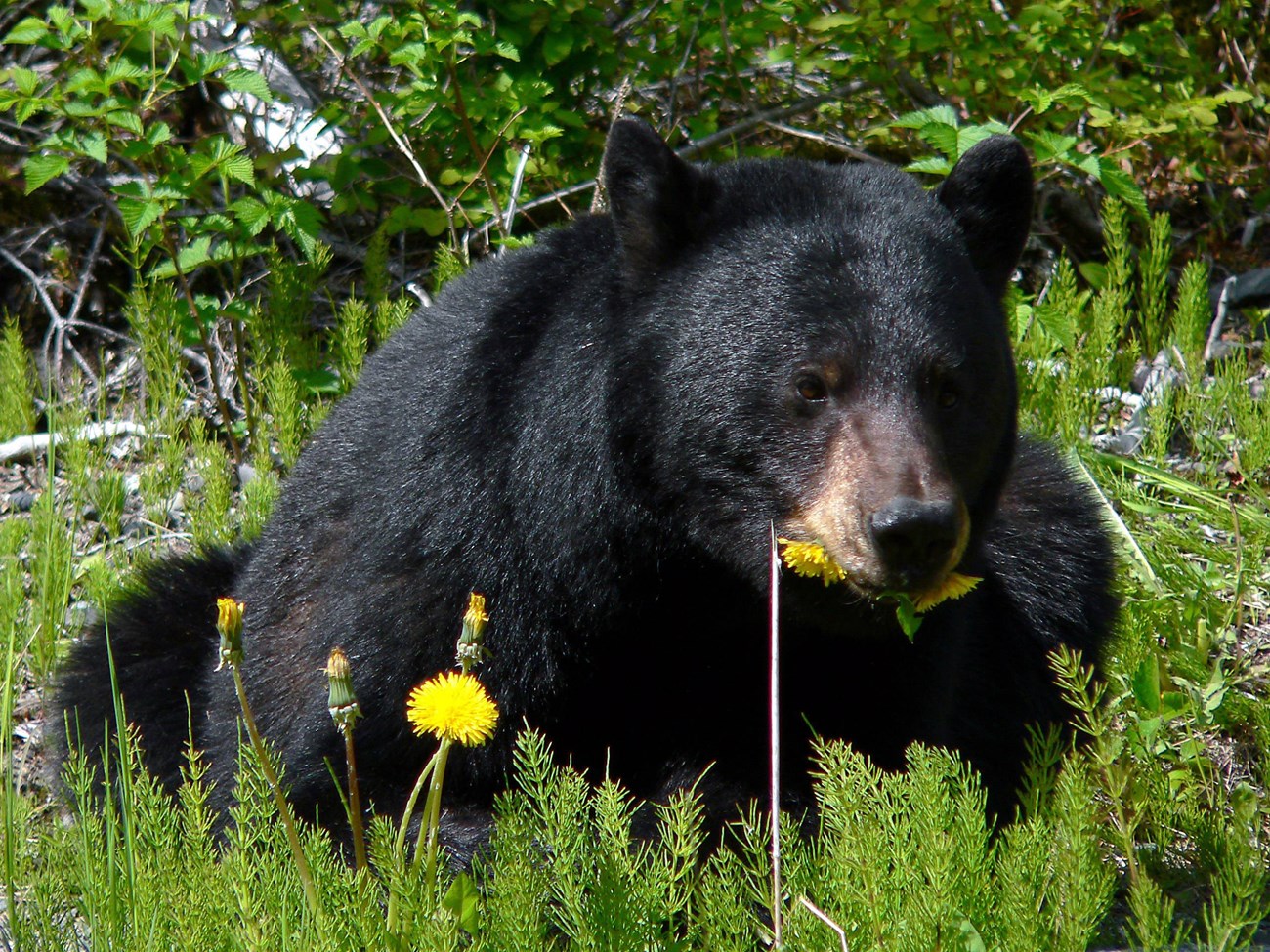Last updated: July 21, 2021
Article
American Black Bear

NPS/Eric Johnston
Visitors, rangers, and bears, oh my! You can be sure to find park rangers and visitors on any trip to a national park, but did you know that in many of this region’s parks, you may also encounter black bears (Ursus americanus)?
General Description
Unlike its name suggests, a black bear’s fur ranges from grey to blue-grey, black, cinnamon and even white! Adults are between 1.5 and 1.8 m (5–6 ft) long and can weigh between 90 and 272 kg (200–600 lbs). While this may sound large, black bears are the smallest North American bear. The black bear’s flat back distinguishes it from a grizzly bear (Ursus arctos), which has quite a pronounced hump on its shoulders. Black bears also have small heads with straight-line profiles, rounded ears, non-retractable claws on their paws, and an incredible sense of smell. They are thought to have the keenest noses in the animal kingdom, but their sense of smell is so good that it is difficult to measure! Black bears are the only species of bear currently in southern Oregon and northern California.
Range and Preferred Habitat
Black bears are common throughout the Pacific Northwest’s forests and mountains. They are also found in forests throughout Canada, Alaska, the Rocky Mountains, the upper Midwest, parts of the southern U.S., the Appalachian Mountains, and down into Mexico. Black bears live over an individual home range of 24 square kilometers (15 square miles) or more. They will follow seasonal landscape changes to rely on different food sources throughout the year. In the spring, they are commonly found near wetlands and early green-up areas, while in the summer and fall, they will occur near large berry patches. They will often travel along humanmade trails, retired logging roads, and game trails.

NPS
Diet
Black bears are omnivorous, meaning they eat both plants and animals. They rely heavily on their sense of smell for finding food; it is thought that they can smell a food source from over two miles away. Most of their diet consists of berries, fruit, sedges, and insects. They will also occasionally consume fish, honeycomb, and human food and garbage, so it is important to make sure to keep your items locked up with bear-proof equipment! In the spring, black bears may prey on young elk and deer. They even occasionally hijack carcasses of these animals that were killed by another predator such as a mountain lion.
Predators
Black bears may become prey to mountain lions (Puma concolor), wolves (Canis lupus), coyotes (Canis latrans), bobcats (Lynx rufus), grizzly bears, humans, or other black bears. Cubs are especially vulnerable to predation by these other animals.
Behavior
Black bears are largely solitary creatures, except when breeding. They build dens beneath fallen trees, hollowed logs, and other protective shelters. They are diurnal (active during the day) in natural habitats, although they may become more active at night in areas with lots of human activity to avoid encounters with us. Still, be sure to keep your eyes peeled! During the fall, these bears will build up a thick layer of fat to sustain them through their winter sleep; however, they do not truly hibernate! Instead, black bears (like other large mammals) enter a shallow torpor. In this state, similarly to hibernation, a bear’s body temperature decreases and metabolism slows, but to a lesser extent than a true hibernating individual. In torpor, bears do not need to wake to eat, drink, urinate, or defecate, although this state does allow bears to wake up more suddenly if a sense of danger is present.
Reproduction
Black bears mate in summer every two to three years. Females give birth while in their dens to anywhere between one and six cubs in mid-winter (two or three are most common!). Cubs, initially born blind and without teeth, will nurse until the emergence of green vegetation in spring. Young bears stay and grow alongside their mother for about two years before becoming independent, and they reach maturity within three to four years of age. After reaching adulthood, black bears can live up to 30 years old!
Fun Facts
- The most common color for a black bear is actually brown
- Black bears are the smallest bear found in North America
- Black bears do not truly hibernate!
- Bear cubs are born blind, fully furred, and without teeth
Where to See
Black bears occur in over 150 national parks, including all parks in the Klamath Network.
More Information
https://www.dfw.state.or.us/wildlife/living_with/black_bears.asp

Download a pdf of this article.
Prepared by Cassandra Fricke, Southern Oregon University science communication intern
NPS Klamath Inventory & Monitoring Network
Southern Oregon University
1250 Siskiyou Blvd
Ashland, OR 97520
Featured Creature Edition: July 2021
